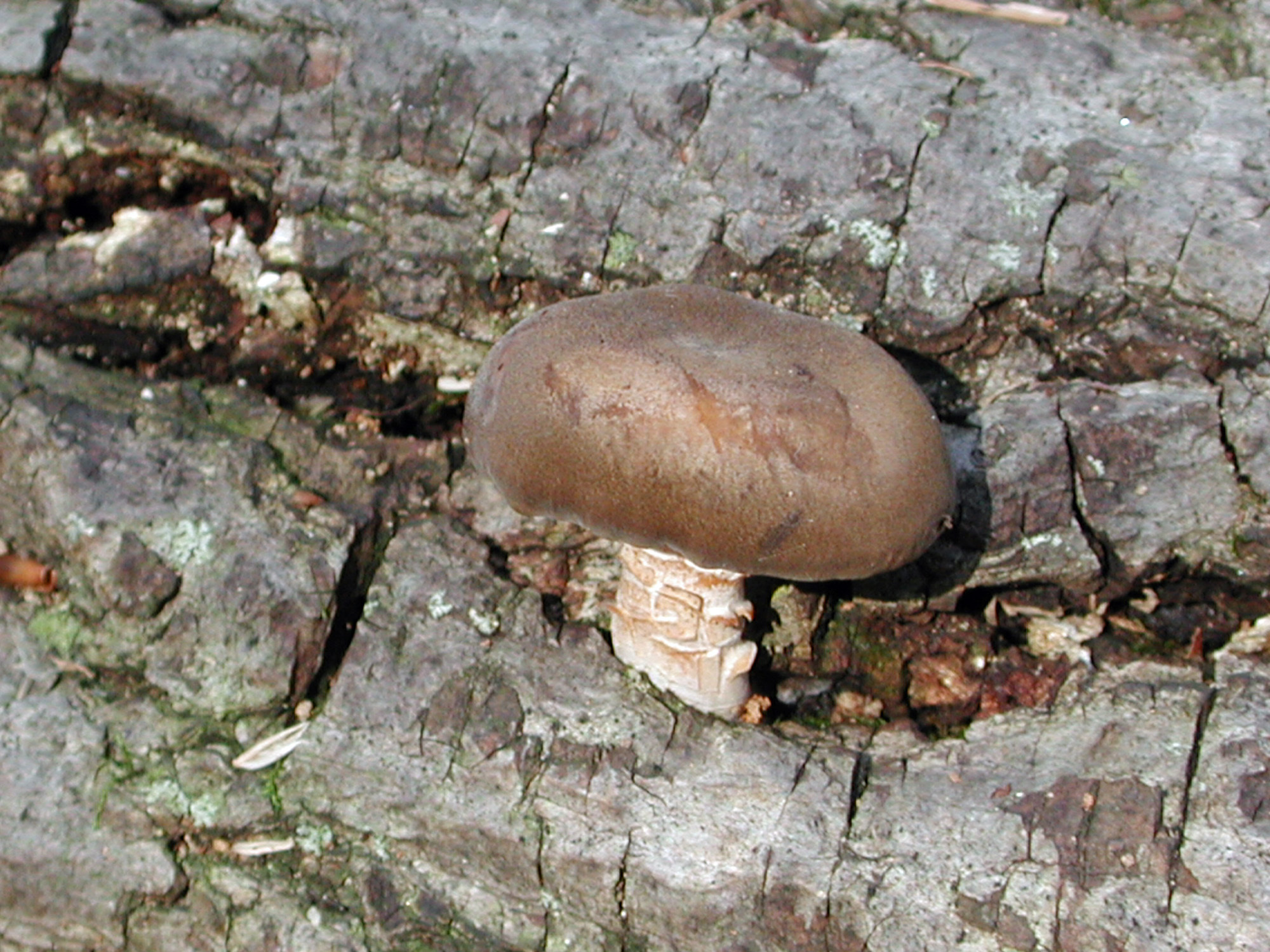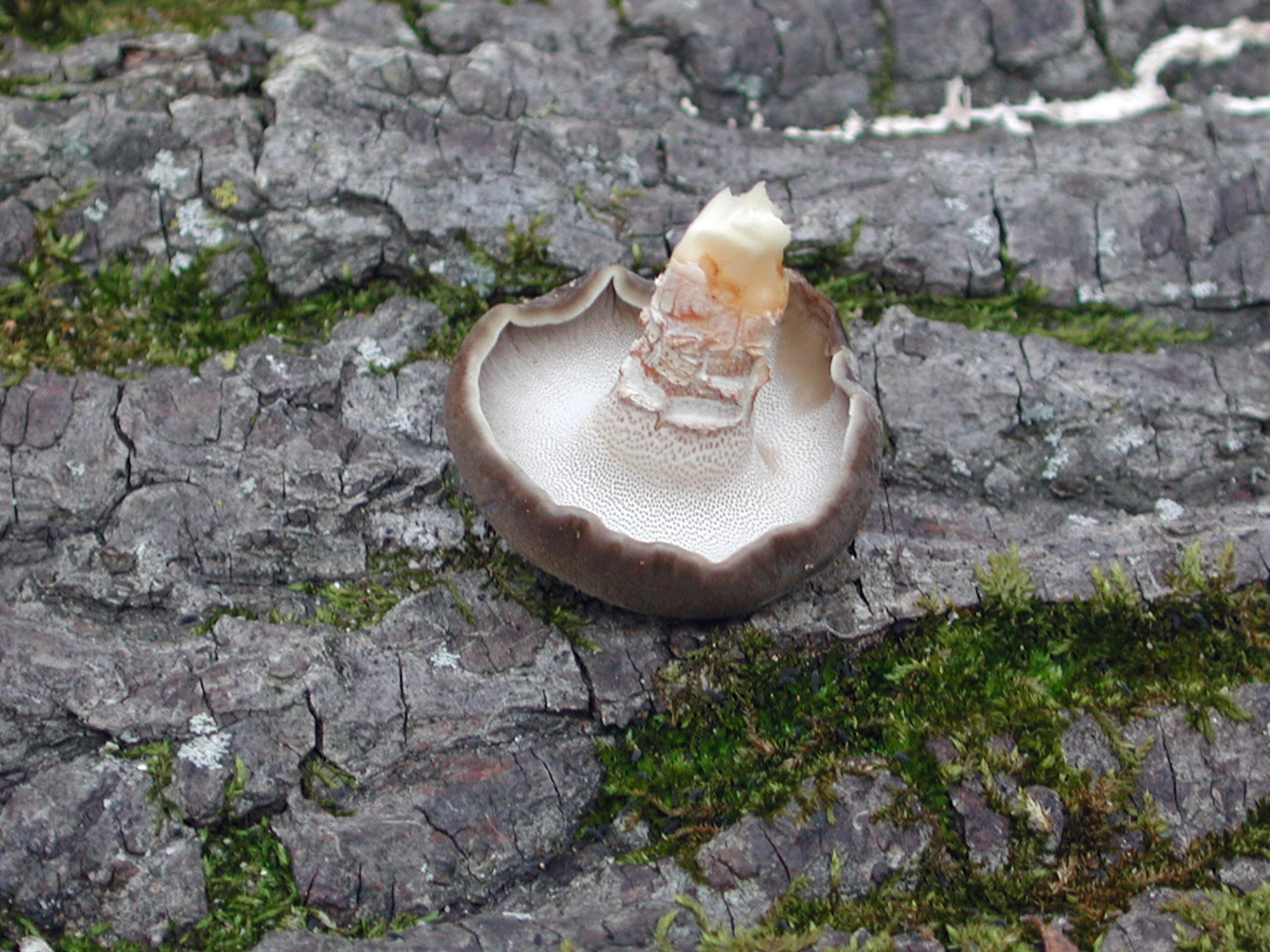Map Snapshot





6 Records
Seasonality Snapshot
Source: Wikipedia
| Lentinus brumalis | |
|---|---|

| |
| Scientific classification | |
| Domain: | Eukaryota |
| Kingdom: | Fungi |
| Division: | Basidiomycota |
| Class: | Agaricomycetes |
| Order: | Polyporales |
| Family: | Polyporaceae |
| Genus: | Lentinus |
| Species: | L. brumalis
|
| Binomial name | |
| Lentinus brumalis (Pers.) Zmitr. 2010
| |
| Synonyms | |
| |
| Lentinus brumalis | |
|---|---|
| Pores on hymenium | |
| Cap is offset | |
| Stipe is bare | |
| Spore print is white | |
| Ecology is saprotrophic | |
| Edibility is inedible | |
Lentinus brumalis is an inedible species of fungus in the family Polyporaceae.[1] Its common name is the winter polypore. The epithet brumalis means "occurring in the winter", describing how this species tends to fruit during winter.[2][3] It causes white rot on dead hardwood,[4] and is distributed throughout the Northern Hemisphere in temperate and boreal zones.[5]
Taxonomy
[edit]Lentinus brumalis was first described as Boletus brumalis in 1794 by Christiaan Hendrik Persoon in his work "Neuer Versuch einer systematischen Eintheilung der Schwämme" (New attempt at a systematic classification of fungi).[6] It was transferred to the current genus, Lentinus in 2010 by Ivan V. Zmitrovich.[7]
Description
[edit]Macroscopic characteristics
[edit]Lentinus brumalis has a round, broadly convex cap that has a diameter of 1.5 to 10 cm (1 to 4 in) and is 0.5 cm (0.20 in) thick. It is depressed in the middle and somewhat zoned. The surface of the cap is dry, though rarely hairy. It ranges from yellow-brown to dark brown in colour. The margin of the cap is often inrolled, particularly in young specimens.[8][9]
There are 3 mm deep pores on the white to cream underside of the cap. They are spaced 2-4 pores per mm2.[10] They have moderately wide, (0.5-)1-1.5 mm large and roundish to almost diamond-shaped pores, which run down the stem a little (decurrent) and are therefore slightly elongated.[11] They change in appearance from dull to lustrous when the orientation to light is changed. The spore print is white.[10]
The stalk is 2.5 to 4 cm (1 to 2 in) long and 2–5 mm thick.[8] It is gray to brown, occasionally with red tints and is generally lighter than the cap.[10] Its dry surface is either smooth or finely felted to slightly scaly.[12] The flesh is white and its consistency is tender to elastic. It does not have a particular taste or odour.[11]
Microscopic characteristics
[edit]The spores are elliptic to cylindrical and measure 5–7 × 1.5–2.5 μm. They are smooth inamyloid, not changing colour when mounted with iodine.[8] The basidia, club-shaped structures that bear spores, have 4 spores each and measure 16–22 × 5–6.5 μm. Cystidia, (large cells found on the fruiting bodies of some fungi) are absent.[10]
Clamp connections are found throughout all tissue. The hyphal system is dimitic, made out of two types of hyphae. The generative hyphae of the flesh is 4–10 μm wide, colourless, thin-walled and occasionally branched. The binding hyphae of flesh has a similar colour and width, though it can sometimes swell up to 13 μm wide. It is thick-walled and nonseptate. It is frequently branched and the branches taper to 1–2 μm wide.[10]
KOH does not affect the colour of any parts of this fungi (negative reaction). When stained by guiaic gum, the flesh turns blue, over a period of 6–12 hours.[12]
Mycochemistry
[edit]L. brumalis produces the black pigment melanin,[13] especially under high levels of moisture content (35%-55%) in the wood substrate.[14] Lentinus brumalis degrades lignin in wood by producing enzymes, primarily lignin peroxidase and laccase.[15]
Growth
[edit]
The stipe of Lentinus brumalis is strongly phototropic (grows towards light) before its cap forms. For example, a 12–300 second exposure to 1500 foot-candles of light can cause the stipe to curve 5–80° within 24 hours. After the cap has formed and reached a diameter of 9mm, the stipe stops growing towards the light, instead becoming strongly geotropic (growing away from gravitational pull).[16]
Ecology and distribution
[edit]It is saprotrophic on dead hardwoods, in particular, birch, beech and mountain ash, though in rare cases it grows on conifers such as hemlock and fir. In Uzbekistan, it grows on European nettle, willow and poplar trees as well.[5] It grows solitary or in small groups.[12] In North America, Lentinus brumalis is more common in the east, where it grows June through October.[4] In Northern Europe, however it fruits in late October, and March.[2]
Similar species
[edit]A potential look-alike, Lentinus strictipes, can be distinguished from L brumalis as it does not fruit until April, as well as possessing smaller, and finer pores, that are rarely larger than 0.5 mm. A closer look-alike, L.arcularius (the spring polypore), differs from Lentinus brumalis in its larger pores, which are up to 2.5 mm wide, and easily recognizable even on young fruiting bodies.[2] Neofavolus alveolaris has a paler cap, larger pores and spores and a more lateral stipe.[10] L. longiporus has significantly longer pores and grows under willows and poplars in April and May. Cerioporus leptocephalus, Cerioporus varius and Picipes melanopus all have a dark black stipe that is not found on L. brumalis.[12]
Research
[edit]Cultures of L. brumalis have been taken onto three different satellites (the Salyut-5 orbital station, the Salyut 6 orbital station and the Cosmo 690) to research the effects of weightlessness, space orientation and light on the geotropism and formation of its fruiting bodies.[17] In the absence of gravity and light, the stipe grew strongly twisted into a spiral or ball, and caps did not form, though in the presence of light, there was little anatomical difference from control samples.[18] However, on Salyut 6, with the samples in the dark, they formed no fruiting bodies.[19][20]
L. brumalis has been studied for its potential ability to degrade dibutyl phthalate. A study in 2007 reported that dibutyl phthalate was nearly eliminated from a culture medium of L. brumalis within 12 days, potentially through transesterification and de-esterification.[21]
Uses
[edit]The fruiting body of L. brumalis is inedible, and it has no use as a dyestuff as it yields little to no colour.[22]
References
[edit]- ^ "Lentinus brumalis in Mycobank".
- ^ a b c Jahn, Hermann (1963). Mitteleuropäische Porlinge (Polyporaceae s. lato) und ihr Vorkommen in Westfalen [Central European polypore (Polyporaceae s. lato) and their occurrence in Westphalia] (in German) (4 ed.). pp. 30–31.
- ^ Polypores and Similar Fungi of Eastern and Central North America. University of Texas Press. 2021. p. 215. doi:10.7560/322727. ISBN 978-1-4773-2273-4.
- ^ a b Phillips, Roger (2010). Mushrooms and Other Fungi of North America. Buffalo, NY: Firefly Books. p. 300. ISBN 978-1-55407-651-2.
- ^ a b Khojimatov, Olim K.; Gafforov, Yusufjon; Bussmann, Rainer W., eds. (2023). "Ethnobiology of Uzbekistan". Ethnobiology: 1257. doi:10.1007/978-3-031-23031-8. ISBN 978-3-031-23030-1. ISSN 2365-7553.
- ^ Persoon, C. H. (1794). "Neuer Versuch einer systematischen Eintheilung der Schwämme" [New attempt at a systematic classification of fungi]. Neues Magazin für die Botanik in ihrem ganzen Umfange (in German). 1: 107 – via Hathitrust Digital Library.
- ^ Zmitrovich, Ivan V. (2010). "The Taxonomical and Nomenclatural Characteristics of Medicinal Mushrooms in Some Genera of Polyporaceae". International Journal of Medicinal Mushrooms. 12 (1): 87–89. doi:10.1615/IntJMedMushr.v12.i1.80. ISSN 1521-9437.
- ^ a b c "Polyporus brumalis (MushroomExpert.Com)". www.mushroomexpert.com. Retrieved 25 February 2024.
- ^ McKnight, Karl B.; Rohrer, Joseph R.; McKnight Ward, Kirsten; McKnight, Kent H. (2021). Peterson Filed Guide to Mushrooms (2nd ed.). Harper Collins. p. 276. ISBN 9780544236110.
- ^ a b c d e f Gibson, Ian. Beug, Michael (ed.). "E-Flora BC Atlas Page". linnet.geog.ubc.ca. Retrieved 26 February 2024.
- ^ a b Gminder, Andreas; Karasch, Peter (2023). Das Kosmos Handbuch Pilze [The Kosmos Mushroom Handbook] (in German). Franckh-Kosmos Verlags-GmbH & Company KG. p. 508.
- ^ a b c d Labbé, Robert (March 2023). "Lentinus brumalis / Winter polypore". MycoQuebec. Retrieved 26 February 2024.
- ^ Sridhar, KR; Deshmukh, Sunil Kumar (2021). "Colourful Macrofungi and their Pigment Structures". Advances in Macrofungi; Industrial Avenues and Prospects. CRC Press. ISBN 9781000460124.
- ^ Tudor, Daniela (14 January 2014). Fungal Pigment Formation in Wood Substrate (PhD thesis). University of Toronto. p. 150.
- ^ Satyanarayana, Tulasi (2005). Microbial Diversity; Current Perspectives and Potential Applications. I.K. International. p. 822. ISBN 9788188237432.
- ^ Giese, Arthur C. (2013). Photophysiology: Current Topics. Elsevier Science. p. 71. ISBN 9781483262284.
- ^ Vaulina, E. N.; Palmbakh, L. R.; Antipov, V. V.; Anikeeva, I. D.; Kostina, L. N.; Zharikova, G. G.; Kasatkina, T. B. (1979). "Biological investigations on the orbital station "Salyut-5"". Life Sciences and Space Research. 17: 241–246. ISSN 0075-9422. PMID 12008713.
- ^ Kasatkina, T. B.; Zharikova, G. G.; Rubin, A. B.; Palmbakh, L. R.; Vaulina, E. N.; Mashinsky, A. L. (1 January 1980), Holmquist, R. (ed.), "Development of Higher Fungi Under Weightlessness", Life Sciences and Space Research, 18, Pergamon: 205–211, doi:10.1016/b978-0-08-024436-5.50028-7, ISBN 978-0-08-024436-5, PMID 11971286, retrieved 25 February 2024
- ^ Zharikova, G. G.; Rubin, A. B.; Nemchinov, A. V. (1977). "Effects of weightlessness, space orientation and light on geotropism and the formation of fruit bodies in higher fungi". Life Sciences and Space Research. 15: 291–294. ISSN 0075-9422. PMID 11962503.
- ^ Moore, David (January 1991). "Perception and response to gravity in higher fungi – a critical appraisal". New Phytologist. 117 (1): 3–23. doi:10.1111/j.1469-8137.1991.tb00940.x. ISSN 0028-646X. PMID 11541309.
- ^ Lee, Soo-Min; Lee, Jae-Won; Koo, Bon-Wook; Kim, Myung-Kil; Choi, Don-Ha; Choi, In-Gyu (15 August 2007). "Dibutyl phthalate biodegradation by the white rot fungus, Polyporus brumalis". Biotechnology and Bioengineering. 97 (6): 1516–1522. doi:10.1002/bit.21333. ISSN 0006-3592. PMID 17221890.
- ^ Bessette, Arleen R.; Bessette, Alan E. (2001). The Rainbow Beneath My Feet; A Mushroom Dyer's Field Guide. Syracuse University Press. p. 164. ISBN 9780815606802.
External links
[edit] Media related to Polyporus brumalis at Wikimedia Commons
Media related to Polyporus brumalis at Wikimedia Commons Data related to Polyporus brumalis at Wikispecies
Data related to Polyporus brumalis at Wikispecies

